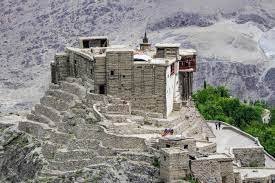Baltit Fort is a historic fortification
Baltit Fort is a historic fortification located in the town of Karimabad in the Hunza valley of the Gilgit-Baltistan region in Pakistan. It is one of the oldest and most significant landmarks of the region and has played an important role in the region's history and culture.
The fort is believed to have been built around 700 years ago, during the time of the Ayasho dynasty. At the time, it was a small watchtower that was used as a lookout point by the local villagers to keep an eye on the surrounding area. Over the centuries, the fort was gradually expanded and fortified by the Mirs (rulers) of Hunza.
The fort's strategic location made it an important military stronghold, and it was the site of many battles and conflicts in the region. The Mirs of Hunza used the fort as their seat of power, and it was also a center of trade and commerce, as it was located on the ancient Silk Road.
In the 16th century, the fort was further enlarged and fortified by the Mirs of Hunza. They added many new rooms and chambers, and also constructed a new tower and a mosque within the fort's walls. The fort's impressive architecture and strategic location continued to make it an important military and political center in the region.
During the 19th and early 20th centuries, the fort began to fall into disrepair as the power of the Mirs of Hunza waned. It was abandoned and left to decay, and it was only in the 1940s that efforts were made to restore and preserve the fort.
In 1945, the Aga Khan Foundation took on the task of restoring the fort, and it was carefully renovated and converted into a museum showcasing the culture and history of the Hunza valley. The restoration work was carried out by local craftsmen and artisans, who used traditional building techniques and materials to preserve the fort's historical authenticity.
Today, Baltit Fort is a popular tourist destination and a symbol of the region's rich history and culture. Visitors can explore the fort's many rooms and chambers, including the impressive throne room, which is adorned with intricate carvings and decorations.
The fort's strategic location on a hilltop provides breathtaking views of the surrounding valley and mountains, making it a popular spot for photography and sightseeing. The fort's architecture and historical significance continue to fascinate visitors from around the world, and it remains an important symbol of the region's cultural heritage.
In 2004, Baltit Fort has declared a UNESCO World Heritage Site, in recognition of its historical and cultural importance. This designation has helped to increase awareness of the fort's significance and has encouraged further efforts to preserve and protect it for future generations.




Comments
Post a Comment